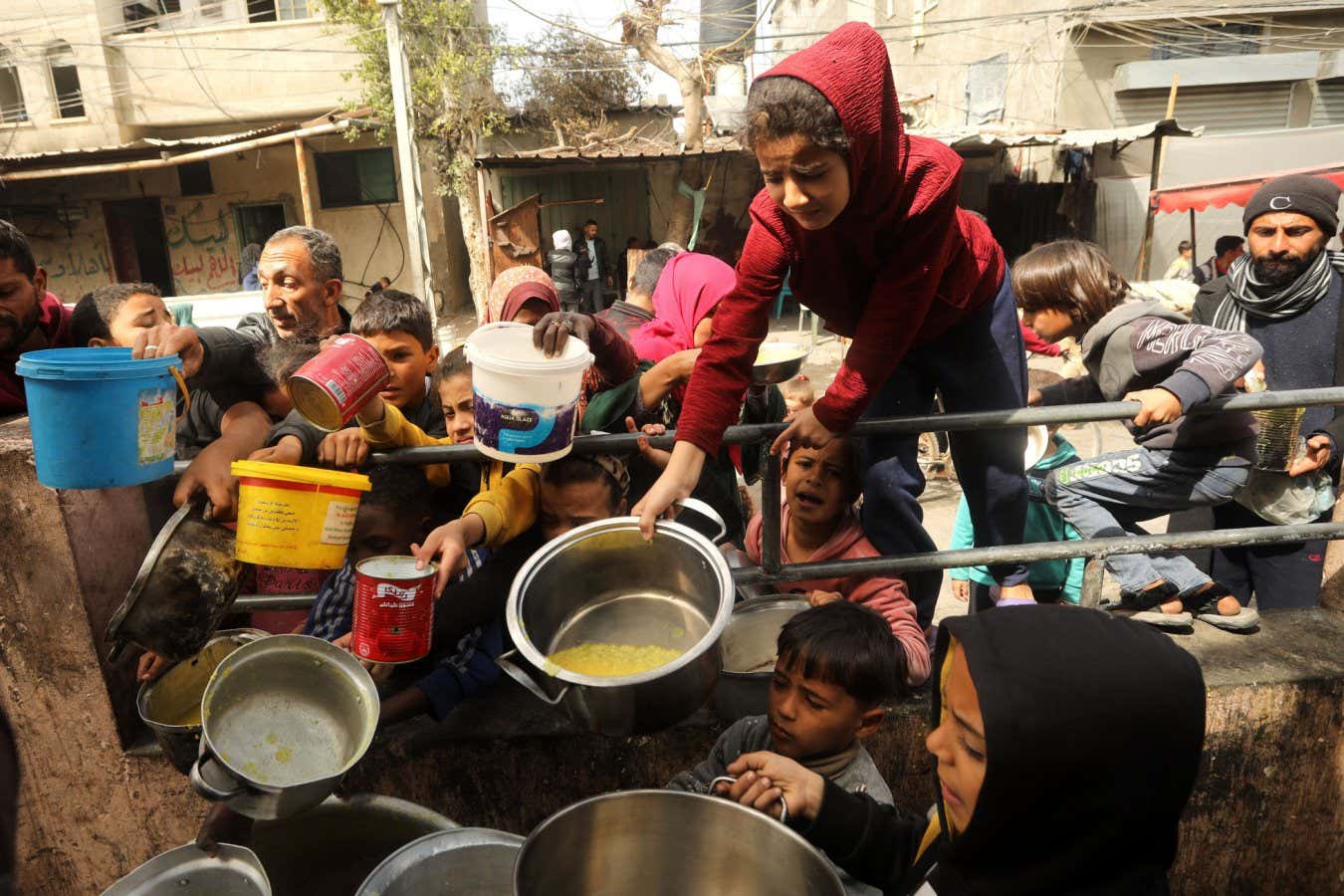

Palestinian children wait to receive food cooked by a charity kitchen amid shortages of food supplies in Rafah
Ismael Mohamad/UPI/Shutterstock
The situation in Gaza is rapidly devolving into the worst humanitarian crisis in modern memory, and international health organisations have no long-term plans for addressing the territory’s post-war needs.
More than three-quarters of Gaza’s 2.2 million residents, half of whom are children, are internally displaced, trapped in one of the most densely populated areas in the world with minimal access to food, water or healthcare. Since 7 October, when Hamas militants from Gaza invaded Israel and killed more than 1000 civilians, Israel has intensely bombed the enclave, hindered the flow of humanitarian aid and decimated civilian infrastructure. As a result, more than 30,000 Palestinians have died in Gaza – mostly women and children – according to the United Nations, and more than 72,000 have been injured.
Yet, these figures signal only the beginning of the public health catastrophe. Those who survive the war will face lifelong health effects. Thousands of Palestinians will be living with missing limbs, compromised immunity, mental illness and other chronic conditions. Meeting their health needs will be a decades-long undertaking, one that no global aid organisation has adequately planned for.
The World Health Organization, the World Food Programme, UNICEF, the Palestine Red Crescent Society, CARE International and Doctors Without Borders all lack concrete, long-term plans to address health needs in Gaza, according to information each organisation shared with New Scientist. Save the Children and the International Committee of the Red Cross didn’t provide a response to questions about their long-term plans.
An unprecedented humanitarian disaster
The lack of planning for the coming decades of healthcare needs is partly due to the enormity of the current humanitarian crisis. Most people in Gaza are living in crowded conditions without sewage treatment and trash removal. On average, people have less than 1 litre of clean water per day. As a result, infectious disease is rampant.
A survey in a limited number of shelters in December and January found that at least 90 per cent of children under 5 years old have one or more infectious illnesses and 70 per cent have had diarrhoea in the past two weeks. “And that doesn’t account for the hundreds of thousands of people who aren’t in refugee shelters,” says Margaret Harris at the WHO.
Hunger is also widespread. Almost two-thirds of households eat one meal a day, and a quarter of the population faces imminent starvation and extreme malnutrition. Conditions are most dire in northern Gaza where 1 in 6 children are malnourished, according to the survey. Gaza’s health ministry reported on 7 March that 20 people, including 15 children, have died from malnutrition and dehydration. Poor surveillance means these numbers are likely much higher.
“The difficult thing about malnutrition in children is that it begets more illness,” says Tanya Haj-Hassan at Doctors Without Borders. Malnourished children are more susceptible to infections, which wears the intestine’s lining, making it difficult to absorb nutrients. “So, they become more malnourished, more immunocompromised, and it just becomes this vicious cycle that’s essentially a snowball down to death,” she says.
Bombing has made much of the territory unsafe. UNICEF found that by December, more than 1000 children had lost one or both of their legs since the conflict began – or more than 10 children a day, on average. And there are few options to obtain care for these injuries: as of 21 February, only 18 of the 40 hospitals in Gaza were still functioning, but with reduced capacity. “They don’t have drugs. They don’t have machines. They don’t have power. They might have a few doctors who are running an emergency room. So, there’s really no functioning health system,” says Selena Victor at humanitarian organisation Mercy Corps, which is providing emergency food in Gaza.
The overwhelming humanitarian crisis has left health organisations scrambling. “We’ve not seen such a level of violence, horror, fear and deprivation enacted on any population in modern history,” says Harris. “We are, in a sense, charting unknown territory.”
Gaza’s impending public health crisis
Even if the war ends tomorrow, survivors will face lifelong health consequences. Many will have physical disabilities. Others will have severe mental illness. Some may develop chronic lung conditions, heart disease and cancer from the chemical pollutants in bombs and destroyed buildings, says Harris.
The impact will be most severe for children. Persistent malnutrition early in life stunts growth and impairs brain development, causing deficits in cognition, memory, motor function and intelligence, says Haj-Hassan. It also weakens children’s immune systems, leaving them vulnerable to illness. Research shows that malnutrition during pregnancy increases the risk of babies developing obesity, hypertension, heart disease and type 2 diabetes. A February report from Project Hope, an international aid organisation, found that 1 in 5 pregnant women treated at a Gaza clinic were malnourished, as were 1 in 10 children seen there.
However, the most widespread harm will be the mental health effects, says Harris. “Just imagine what it’s like for the people who are going through this every day relentlessly. They have a terrible sense of uncertainty – no idea where to go, what’s going to happen next, where the next little bit of food is going to come from,” she says. Such traumatic experiences are associated with depression, anxiety, post-traumatic stress disorder (PTSD) and suicidal thoughts. In children, this trauma can disrupt brain and organ development and increase the risk of learning disabilities and mental health conditions. Without early interventions, these problems may continue into adulthood. “We’re going to see an enormous burden of mental illness that is going to be extremely difficult to deal with,” says Harris.
Adults who experience childhood adversity also have 12 times the risk of developing alcohol and drug use disorders and attempting suicide. They are more likely to have physical health conditions, too, such as heart disease or cancer. Young men who survive conflict have almost triple the rates of severe mental disorders, such as psychosis, compared with those who don’t experience war.
Current post-war plans are not enough
Given these consequences, long-term health plans for Gaza must be established. Such plans will have to address rebuilding infrastructure, developing mental and physical rehabilitation programmes and routinely screening for illness.
“It seems absurd to be talking about what the municipal authorities will look like when right now people are dying trying to get a handful of bread for their families. It just doesn’t compute,” says Victor. “But we need to think about it.”
Yet, most organisations have only just begun to do so. The few with protocols in place – including the Palestine Red Crescent Society and CARE International – address the next year or two, but not decades down the line. The WHO is developing plans to address health needs from April 2024 to the end of the year. “We’re working with several different scenarios. The good scenario is a ceasefire that helps us to then genuinely look at [long-term plans],” says Harris. The other plausibility is that the war continues.
This uncertainty, along with the looming question of who will govern Gaza in the aftermath of the conflict, makes future preparations extremely difficult. “Why we are desperate to see not just a ceasefire, but a peaceful resolution, is that until we’ve got that, any plan, anything we even consider, is just castles in the air,” says Harris.
Israel has limited aide organisations’ access to the region, and the few workers who are in Gaza can’t operate safely. “Half the time they can’t do anything. They can’t move around safely. Basic things like communications keep getting shut down,” says Victor. And many of them have died. For instance, a member of the WHO’s limb reconstruction team in Gaza, a 29-year-old named Dima Abdullatif Mohammed Alhaj, was killed by an Israeli airstrike alongside her 6-month-old baby, two brothers and husband, says Harris.
These dangers and hurdles complicate long-term planning. “You can make any plan you like, but if you don’t know what the needs are, you’re not going to make a very useful plan,” says Victor.
It will take an enormous amount of money to address the widespread devastation in Gaza. Margaret Harris at the World Health Organization says that early estimates suggest $204.2 million will be needed to fund its health emergency plan in Gaza for 2024 alone.
Meanwhile, a spokesperson for the Palestine Red Crescent Society says the organisation has a $300 million budget for its campaign in Gaza, which will run until the end of 2025. Roughly $38 million of those funds will be used for the health sector, including restocking medical supplies, deploying additional ambulances and preventing infectious disease.
This won’t begin to address the long-term health needs of Palestinians in Gaza. It is hard to estimate what will be needed now, but Harris says that in the long run “I think it is fair to say we’ll be looking at billions”.
Article amended on 12 March 2024
We clarified the role of Mercy Corps in the region
Topics:







